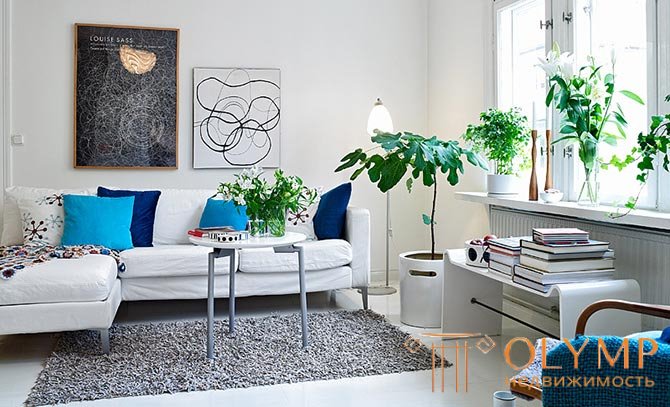

The most irresponsible step is the impulsive acquisition of a houseplant with the subsequent thoughtless placement (for example, on a window sill or on a single free table). Breeding houseplants is not child's fun, but a highly responsible and not simple occupation that needs to be thought out to the smallest detail.
Already in advance, before buying a plant, it is necessary to consider the question of its placement in a room. Perhaps a careful analysis of the pattern of wallpaper or the color of furniture will force you to abandon the purchase of a certain type of plants. It is better to prepare several options for the most suitable plants and already in the flower shop to choose the most appropriate one for the price or some other parameters.
The first thing you should pay attention to is the dominant color scheme of the room, namely the coloring of wallpaper and furniture.
The combination of plants with wallpaper is a particular problem. For most plants, a monochromatic wall of light pastel color is an ideal background. At the same time variegated plants and plants with light flowers look better on a darker background. For most plants with variegated leaves or multi-colored flowers, not only the tone, but also the background color is of great importance. So, red flowers and leaves can be highlighted with a green background. Scarlet flowers and plants with dark red foliage on a white window sill look beautiful. Plants with orange flowers will most effectively look on a blue background, as well as next to plants with blue or blue foliage.
Against the background of patterned wallpaper, it is recommended to place plants with large leaves, as the small-leaved specimens simply merge with the background. At the same time, the outline of the plant should not repeat the pattern of wallpaper. Sansevieria with long narrow leaves is unlikely to look beautiful against a background of wallpaper with vertical stripes, where a plant of a spreading shape is more appropriate.
Of great importance for the harmonious arrangement of ornamental plants is the coloring of furniture. So, against the background of light-colored furniture, ivy, forget-me-nots, bluebells and tradescantia look good with large bright leaves. Dark brown furniture will serve as an ideal background for plants of a light green range, plants with white flowers, as well as for plants with variegated leaves.
The houseplant can be placed literally on any part of the room: on the floor, on the wall, on the windowsill, on the furniture and even hung from the ceiling. But it should not neglect such parameters as the shape of the plant and its need for light, heat and moisture.
As a rule, large single plants are placed on the floor in a beautiful flowerpots. This choice is explained very simply: a large plant can not be put on the table, and even more so on the window sill. At the same time, a tall plant with an erect stem will visually increase the height of the ceilings, while a large plant of a spreading shape "makes" it smaller.
A hanging basket with a single ampelous plant or a hanging garden can be screwed to the ceiling. At the same time the ampelous plant will visually reduce the height of the ceiling. Hanging baskets are not recommended to hang in places of heavy traffic, where they will simply interfere with the passage (the same applies to outdoor plants). Suspended plant should be in good condition and differ in high decorative qualities. The vessel located in the basket must be waterproof at least at the bottom. Caring for plants suspended from the ceiling is associated with certain inconveniences. For watering is better to use a watering can with a long spout.
Что бы оставить комментарий войдите
Комментарии (0)